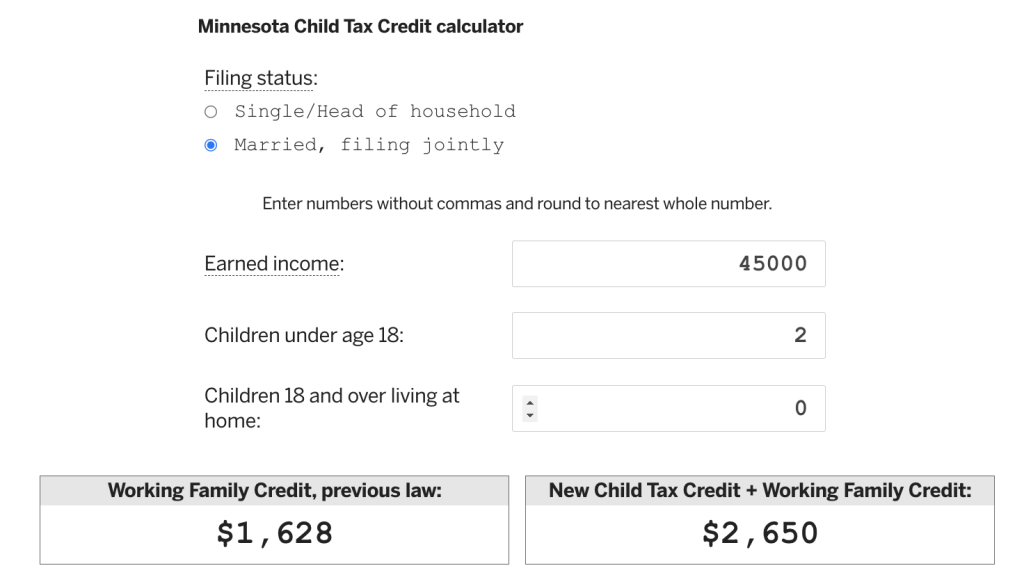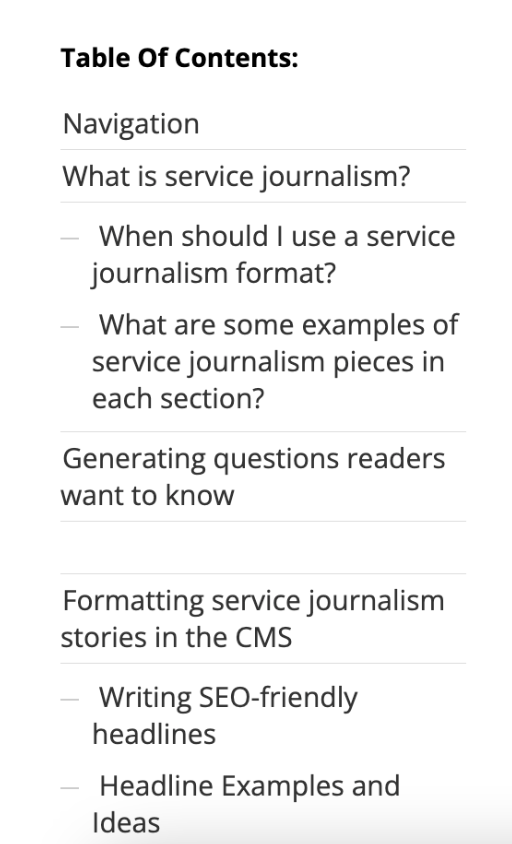During my time as an RJI Student Innovation Fellow at the Star Tribune, I created a best practices document that taught reporters and editors how to pitch service journalism stories and package them online to follow SEO best practices. Throughout this process, I used product thinking to understand where the organization was currently succeeding in delivering stories to audiences online and where knowledge gaps remained.

Understanding current wins and needs in service journalism
Analyzing existing story formats
As the Star Tribune sought to create more content for digital audiences, the outlet lacked a standardized way to discuss and display service journalism stories online. Different sections had different formats for organizing information that did not always align with SEO best practices.



A few of the different service journalism story forms presented on the Star Tribune’s website.
To understand the types of content the newsroom was creating, I did an inventory of the past six months of service journalism stories. This allowed me to see the types of stories that were being created within each section, as well as their inconsistencies.

Through this work and past analysis, we noticed that our Curious Minnesota series performed exceptionally well online. These stories answered questions readers were curious about, using headlines framed as questions to rank well in search results and digital designs that made stories easy to navigate for digital audiences. They performed well in analytics too, regularly receiving page views that were five times higher than newsroom averages.

Finally, I spoke with 37 staff members, including reporters and editors, to find out their current workflows for creating service journalism stories. These conversations were helpful to understand where our guide could help solve gaps in our workflow. Reporters and editors said the previous emphasis on the print edition led to the creation of many narrative, day-turn stories about regular institutional meetings, like city council. Because our reporters are experts in their beats, they expressed that they struggled to understand what questions the average reader may have about their beat. Finally, they wanted to understand how to pitch service journalism stories and feel encouraged by their editors to pursue alternative story formats not traditionally seen in a print newspaper.
Editors also expressed concern that the organization was using too many of the same headline styles. Many also said they did not know the best ways to optimize these stories to appear in search results. This gave us a good idea of where our guide could help educate the newsroom.
We identified the problems within our target audience for the guide that we sought to solve. They want to know:
- What service journalism was and when it was appropriate to produce these digital-first story forms
- The questions the average reader may have about a specific topic
- Headline formats to avoid repetition across story content
- Best ways to optimize these stories online for search traffic
- How to elevate their page designs for a digital audience
Meeting with experts
We also spoke with members of the digital and print design teams to learn the ways templates were made for stories like Curious Minnesota and how they translated into the print product. This helped inform recommendations on the designs reporters could create for their stories and the proper channels to coordinate with the digital design team. This also ensured any formatting that occurred with headers would translate appropriately to a print design page.
Finally, the Star Tribune hired an SEO consultant during the summer of my fellowship, which analyzed our story traffic and provided insights to optimize stories. These recommendations were then translated into our service journalism guide to ensure consistency and accuracy for our newsroom.
Defining service journalism
See the full service journalism guide here.
Before giving recommendations to the newsroom, we wanted to make sure everyone understood what service journalism was and the purpose it served in reaching our digital audience. After noticing inconsistencies between sections in how service journalism stories appeared online, we categorized service journalism stories into four categories.
Read more about this work in a piece I wrote for the Reynolds Journalism Institute during my fellowship.
Q&A Explainer

Q&A Explainers are probably the types of stories you think of when considering a service journalism story. Readers who may not have closely followed a complex story will click on these stories, said Eric Roper and Matt DeLong on the Star Tribune’s audience team. They use subheadings that are phrased as a question or with keywords related to the topic. Here’s an example of one the Star Tribune wrote about the pandemic.
How-to articles

How-to articles are helpful to walk readers through a complicated process, like making an appointment for a COVID-19 vaccine.
Listicle

Listicles often use numbers in their headlines and subheadings to create a list of key points or ranking of recommendations, like the Star Tribune did for Valentine’s Day.
Interactives

Interactives can allow readers to input information and interact with a page to get custom results. They help readers understand how a complicated policy directly affects them, like this story calculating tax credits based on a new Minnesota law.
Many of these custom interactives required help from our newsroom developer.
Creating helpful prompts for reporters and editors
Once we had defined the forms service journalism could take online, we included research-backed recommendations based on the feedback given from reporters and editors. These tips included ways to generate reader questions, write SEO-friendly headlines and fill out search fields in Chorus, our CMS. This helped fill the educational gap we noticed in our initial interviews with stakeholders.

User testing and next steps
The service journalism guide was hosted in our Strib Library, a searchable database of Google Docs to host documentation on different processes.
To test the recommendations, we worked with the Star Tribune’s politics team, who frequently wrote service journalism stories that performed well. The team used the guide for a week and then met with me to provide their feedback.
Through this feedback, we learned that the document needed to be easy to navigate to be useful. The guide was contained within one document with clickable headers for navigation. This way, reporters and editors could quickly find resources for the project.
After deploying the service journalism guide to the entire newsroom, we checked in with reporters and editors to see how they were using the guide. Many said they enjoyed using the guide to quickly reference during the packaging process.

I also hosted a brownbag session where the entire newsroom was invited to learn about the guide and tips for writing more service journalism stories.
08_04-Strib-U-Presentation_ServiceWhile the guide remains pinned within the Star Tribune’s resources channel and in its Strib Library, we hope to iterate on this guide even further. We would like to code Slackbots to search documentation to make it easier for reporters and editors to understand what resources have already been created.